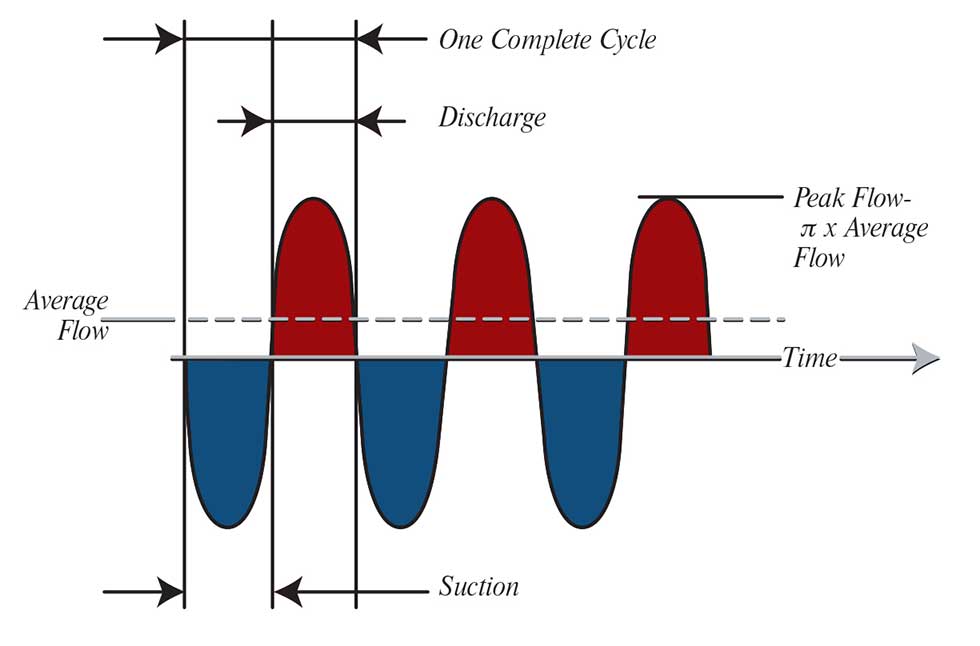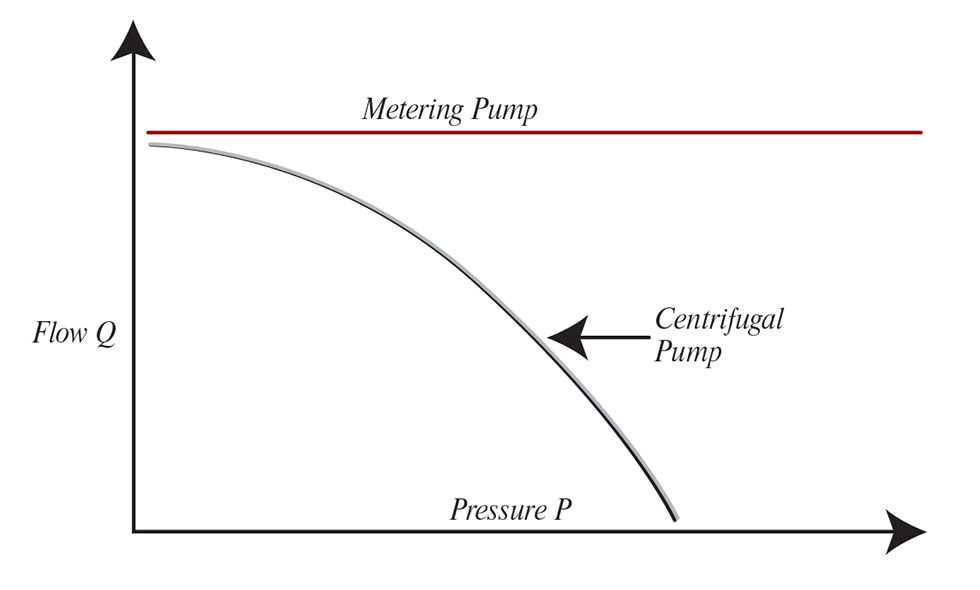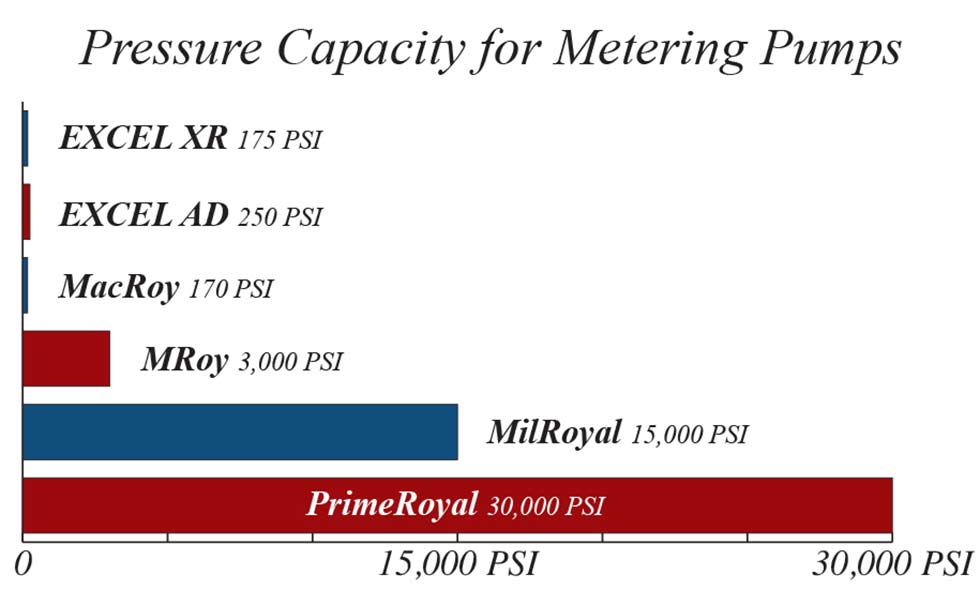
The metering pump is a positive displacement chemical (and water, food processing, etc.) dosing device with the ability to vary capacity manually or automatically as process conditions require. Approximately 90 percent of all pumps sold are transfer pumps, which are designed to move liquids from point A to point B. But metering pumps are specialty pumps: They are designed for the precision-injection of chemicals, acids, bases, corrosives or viscous liquids and slurries. Metering pumps are required for applications where one or more of the following conditions exist:
- High accuracy feed rate is demanded
- Low flow rates in total volume per infusion time (mL/hr) or gallons per hour (gph) are required
- High system pressure exists
- Flow rates vary and must be controlled by computer, microprocessor, distributed control system (DCS) or programmable logic controller (PLC)
- Corrosive, hazardous or high temperature fluids are handled
- Viscous fluids or slurries need to be pumped

Metering Applications
There are thousands of applications that require corrosion inhibitors, wax inhibitors, biocides, antifreeze, disinfectants, coagulants, oxygen scavengers, polymers, softening agents, acids/bases, process additives and other types of chemicals for their processes. The main industries that purchase metering pumps include:
- Industrial water treatment (cooling towers and boilers)
- Potable water and wastewater treatment
- Oil and gas production
- Chemical and petrochemical processing
- Power generation
- Agriculture
- Manufacturing
- Food and beverage production

How They Work
The pump’s motor drives a piston to create a vacuum that pulls chemicals into the liquid end of a metering pump from external tanks. Alternating piston strokes create pressure that closes the inlet valve, opens the outlet valve and forces the chemical out to the process. Within the liquid end is a diaphragm, which acts as a barrier between the piston and the process fluid. Sometimes a diaphragm is mechanically connected to a piston. A diaphragm can also be hydraulically connected.
The piston’s pumping motion is applied to hydraulic fluid, which causes the diaphragm to flex back and forth as the piston reciprocates. The movement of the piston flexes the diaphragm—the more the diaphragm flexes, the higher the flow rate for the pump. The rate of flow can be precisely controlled to ensure that the process receives just what it needs, without over/under injecting.
Metering Pump Characteristics
The pumping action is developed by a reciprocating piston. This reciprocating motion develops a flow that is easily represented by a sine wave. Actual flow rate is determined by the formula below:
- Flow rate = displacement x cycles per unit of time
Unlike a centrifugal pump, the flow rate for a metering pump is not greatly affected by changes in discharge pressure.

Capacity & Pressure Capabilities
Some metering pump applications (such as industrial water treatment) require low pressure (under 100 pounds per square inch [psi]), while other applications (like flow assurance for offshore oil and gas production) require enormous pressures (exceeding 20,000 psi). To address these wide ranges, metering pumps are typically designed in product families with multiple models that can address different flows and pressures.
The maximum capacity of each pump is determined by gear ratio, piston diameter and motor revolutions per minute (rpm). As the piston diameter and stroking speed increase, pressure capability decreases.
Basic Components
- Driver: The pump is usually driven by an alternating current (AC) constant speed motor. Variable speed, pneumatic and hydraulic drivers are also used. Smaller pumps use solenoid coils as an economic drive mechanism.
- Driver mechanism: The drive mechanism translates the rotary motion of the driver into reciprocating movement. Industrial duty pumps submerge this portion of the pump in an oil bath to assure reliability during continuous operation. Solenoid pumps use an electromagnetic coil to directly create linear motion.
- Flow adjustment: Pump flow rate is adjustable by varying stroke length, effective stroke length or stroking speed. Most metering pumps are supplied with a micrometer screw adjustment, or an electronic or pneumatic actuator to adjust pump flow rate in response to process signal.
- Accuracy: The steady state accuracy of a correctly installed, industrial-grade metering pump is generally +1.0 percent or better. Although a metering pump can generally be adjusted to pump at any flow rate between 0.0 and its maximum capacity, its accuracy is measured over a range determined by the pump’s turndown ratio.
- Today’s hydraulically actuated metering pumps have a turndown ratio of 1,000 to 1.0, which means the pump will accurately dose chemicals anywhere between 0.1 percent and 100 percent of its rated capacity.
- Liquid end: The liquid end is referred to as the “wetted” part of the pump. Its ability to protect plant personnel and the environment are important considerations when dealing with toxic or hazardous chemicals. Stainless steel, nickel alloys or plastic materials are typically used depending on the application’s specifications, which include: temperature, flow rate, fluid viscosity and the corrosiveness of the materials that will be pumped.
Enhancements have been made recently with smart materials that enable pump manufacturers to design smaller, more efficient and more powerful pumps that can run longer and more reliably.
New Materials
Some metering pumps now offer liquid end technology, which can provide safety and precision at low injection rates—and with a smaller footprint.
These metering pumps are able to achieve the same flow rate and injection pressure performance as a packed plunger liquid end while maintaining the same performance and safety as a hydraulically balanced diaphragm liquid end. New materials like the shape memory material called polyetheretherketone, or PEEK, have made some of these tweaks possible.
Because the material consistently returns to its original form, the design, which is compliant with American Petroleum Institute (API) standards 675, minimizes the pump’s susceptibility to hydraulic cavitation. Also, metering pumps that have a cast iron gear box can be used in harsh environments.
Another new function to consider is an intrinsic multifunction valve, which can function as a hydraulic oil refill valve and a hydraulic oil air bleed valve. The hydraulic oil reservoir (1.4 ounces/40 mL) can display the pump’s hydraulic oil level, function as a hydraulic safety valve and provide over-pressure indication. A hermetically sealed, leak-proof liquid end can preclude the need for a large reservoir of hydraulic oil.
Old & New
The first hydraulically actuated diaphragm metering pumps were patented in the late 1940s. Since then, many of the applications they are used for (and the corresponding chemicals they pump) have not changed much.
The last few years have seen a number of innovations in metering pump design, in the form of lighter construction materials that produce smaller and more efficient pumps, to other design enhancements that deliver greater hydraulic power and enable pumps to run longer and operate more reliably.
New monitoring technologies have increased the diagnostic capabilities of today’s metering pumps enabling operators to access pump performance and anticipate maintenance issues before they become a problem. Communications capabilities have increased significantly in recent years. Many metering pumps are deployed on skids with local PLCs that communicate to a plant’s supervisory control and data acquisition system (SCADA), which in many instances can now be accessed remotely via wireless tablets or mobile phones.
In many respects, today’s metering pumps are an ideal blend of old and new technology. By combining reliability that has been proven over decades, with efficiency gained from today’s latest materials and the convenience of wireless communications, pump manufacturers can deliver customized solutions for chemical dosing needs.

